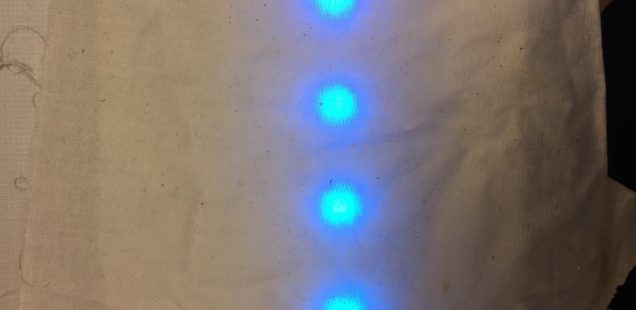
All Things Fabric: Testing, Printing, Pricing
Fabric Testing
As outlined in ‘Face’ of the Quilt, I am testing fabric to see how it diffuses, affects affect, and obscures or reveals hardware. I quickly tested a broad array of swatches. Their textures included felt, mid-weight cotton, a polyester-stretch mix, and lightweight linen. The colors included black, brown, grey, beige, and white. The colors are kept neutral because the background of the quilt will be similar to the original beige.
I was first intrigued by how introductory physics principles became useful: light colored or white fabrics tended to diffuse light while dark colored or black fabrics tended to absorb light and reveal the shape of the LED beneath. I demonstrate this as follows:

This gradient of felt (control for weight and texture) shows how lighter fabrics diffuse light while dark colors absorb them
In regards to the LED hue, there seemed to be less effect on the diffusion because there is a high intensity for all colors. Seen here, we see a slightly different diffusion for blue-toned colors but the diffusion remains mostly consistent:
If I were to pick a personal favorite, it would be the mid-weight cotton-linen mix. The flecks and uneven texture lent it a natural, handmade feel that could be reminiscent of the 1800s quilt – while the modern cool blue light is the perfect juxtaposed touch:
For a full tour of the test, we see below the collective effects of different fabric, where color had a greater effect on diffusion than texture:
Fabric Printing
We are investigating printing the Peabody design from an online fabric design service, Spoonflower, instead of sewing the design ourself. The former not only requires less time and money, but may also provide better presentation.
The idea is to design the topmost layer of the quilt in Illustrator exactly to scale and order the design to scale from Spoonflower. The options for the design are as follows:
- Orange fill on laser-cut design. This layout borrows dimensions from the stencil used to cut holes for the LEDs, such that the grid aligns exactly with where the LEDs shine through.

- Orange grid with major axis, and minor gridlines. This design is closer to the original design that Peabody envisioned.

- Orange grid, thin gridlines, less major axis. This is still more similar to the original Peabody design than #1, but reduces emphasis on a divide. Due to the spacing of our LEDs, this is more likely than #2.

Though the online interface for the Peabody quilt allowed for flexibility on the grid design, we are physically constrained by the spacing of the LEDs which do not account for a major axis.
Next, I discovered that the maximum size for Spoonflower designs is about 21″, though you order fabrics in printable areas ranging from 41″ to about 52″. So, we cannot upload our design as-is. Instead, we need to upload 1 corner of the grid and repeat it in a “mirror” fashion:

Spoonflower design interface. Single corner design selected (first row on left). Shown is a mirror pattern that can be used to print a full grid.
Fabric Pricing
I performed a Python web scrape and export to CSV using Spoonflower’s product page to create a straightforward list of every type of fabric offered and the exact cost for our quilt (1 meter). Though, accounting for error and extra fabric, these costs may be higher.
| Fabric | Measure | Price per Yard | Price for Quilt (1m x 1m) |
| Basic Cotton Ultra | yard | $17.50 | $19.14 |
| Modern Jersey | yard | $26.50 | $28.98 |
| Cotton Spandex Jersey | yard | $26.75 | $29.25 |
| Fleece | yard | $27.00 | $29.53 |
| Minky | yard | $27.00 | $29.53 |
| Satin | yard | $18 | $19.68 |
| Premium Quilting Weight | yd | $19 | $20.78 |
| Cotton Poplin Ultra | yard | $20 | $21.87 |
| Poly Crepe de Chine | yard | $23 | $25.15 |
| Silky Faille | yard | $24 | $26.25 |
| Performance Knit | yard | $24 | $26.25 |
| Lightweight Cotton Twill | yard | $26 | $28.43 |
| Linen Cotton Canvas Ultra | yard | $27 | $29.53 |
| Organic Cotton Interlock Knit Ultra | yard | $27 | $29.53 |
| Organic Cotton Sateen Ultra | yard | $27 | $29.53 |
| Sport Lycra | yard | $32 | $35.00 |
| Heavy Cotton Twill | yard | $32 | $35.00 |
| Eco Canvas | yard | $32 | $35.00 |
| Faux Suede | yard | $34 | $37.18 |
| Silk Crepe de Chine | yard | $38 | $41.56 |

